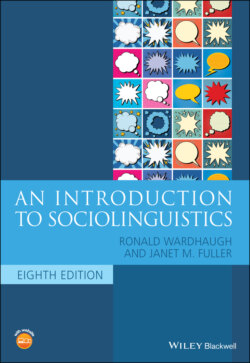Читать книгу An Introduction to Sociolinguistics - Ronald Wardhaugh, Janet M. Fuller - Страница 16
Knowledge of Language
ОглавлениеAs mentioned in the last section, language is culturally transmitted, and while the ability to learn a language is innate, we are not born knowing a particular language, nor are we genetically pre‐dispositioned to speak a certain variety, but we learn the language(s) we are exposed to. The system (or the grammar, to use a well‐known technical term) is something that each language user ‘knows,’ but two very important issues for linguists are (1) just what that knowledge comprises and (2) how we may best characterize it.
In practice, linguists do not find it at all easy to write grammars because the knowledge that people have of the languages they speak is extremely hard to describe. Anyone who knows a language knows much more about that language than is contained in any grammar book that attempts to describe the language. One of the issues here is that grammar books tend to be written as prescriptive works; that is, they seek to outline the standardized language and how it ‘should’ be spoken. What sociolinguistics and linguistic anthropologists do is provide descriptive grammars of languages, which describe, analyze, and explain how and why people actually speak their languages.
One example of this difference can be found in the less/fewer distinction. Prescriptively, less should be used with non‐count nouns, such as water, rice, or money; fewer is used with count nouns (or noun phrases) such as drops of water, grains of rice, or pesos. So something may be worth less money, but it costs fewer pesos. Descriptively, however, this distinction does not hold; less is often used with count nouns. For example, it is common in the US to see signs in grocery stores indicating that certain cashier lines are for patrons with ‘ten items or less,’ although ‘item’ is clearly a count noun. Chances are you will also hear people saying things like there were less students present today than yesterday. While some speakers do still adhere to the less/fewer distinction, it is being lost in some varieties.
Linguistics are aware of prescriptive rules of language as dictated in reference grammars, and they are not irrelevant in sociolinguistics; as we will discuss below, language ideologies are also an important part of how language functions in society. However, in the study of language, linguists focus on descriptive grammar, that is, the rules inside the heads of language users which constitute their knowledge of how to use the language. This knowledge includes underlying rules and principles which allow us to produce new utterances, to know both what it is possible to say and what it is not possible to say. Most language users can’t articulate these rules, but know how to apply them. It is this shared knowledge that becomes the abstraction of a language, which is often seen as something which exists independent of language users. How this knowledge is used by language users is the core of sociolinguistics. In the following sections, we will explore the ways in which sociolinguists and linguist anthropologists have conceptualized language and its users.
